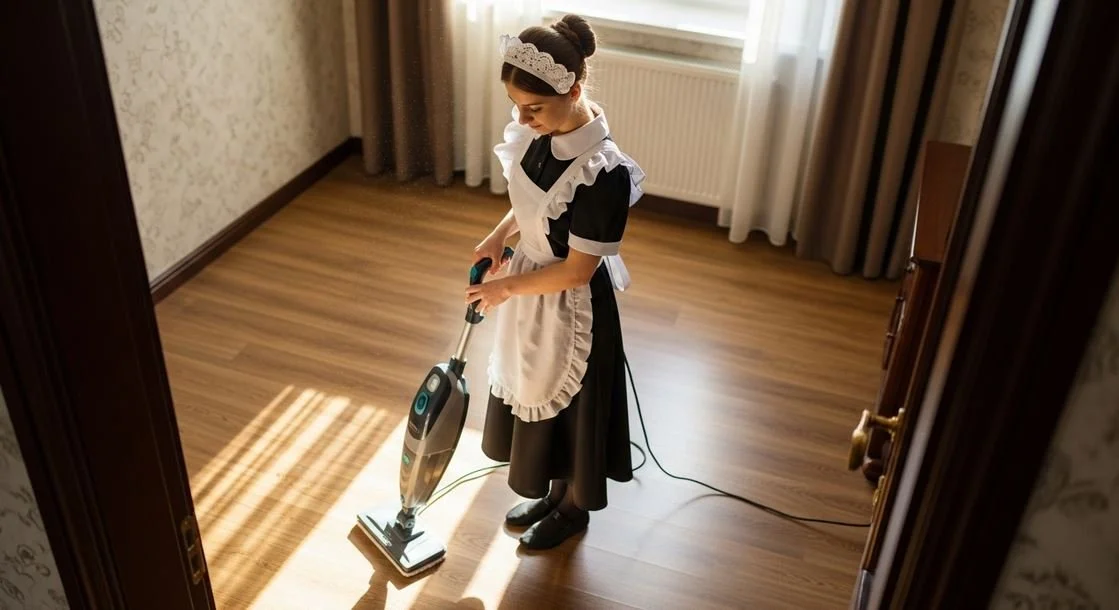Can You Use A Steam Mop On Laminate Floors? (Explained)
There’s something super satisfying about using a steam mop, that whoosh of hot vapor, the instant shine, and the feeling that your floors are getting a deep, chemical-free clean.
But if your home has laminate flooring, you might be wondering if that same applies.
After all, laminate looks sturdy and sleek, so a little steam can’t hurt… right?
Well, not exactly. Laminate may look tough, but deep down, it’s pretty sensitive to moisture and heat. And steam? That’s basically both at once.
In this post, I’ll explain why you shouldn’t use a steam mop on laminate floors.
Should I Use A Steam Mop On Laminate Floors?
You should NOT use a steam mop on laminate floors.
Laminate floors might look like wood, but they’re not built the same way. Under that glossy top layer is a fiberboard core that’s super sensitive to moisture and heat.
Steam mops work by shooting out hot steam under pressure, which is great for sealed tiles or stone, but not for laminate. When you use a steam mop on laminate, that steam can sneak between the seams, soak the layers underneath, and start causing long-term problems.
It won’t always happen instantly, but over time you’ll start to notice changes like soft spots, lifted edges, or dull patches (more on this next).
Also Read: Can You Put Cleaner In A Steam Mop?
Risks Of Using A Steam Mop On Laminate Floors
The risks aren’t just about a little extra moisture. Steam combines water and heat, and that combo is exactly what laminate can’t handle.
Let’s go through the main issues you might face:
#1 Swelling And Warping
Laminate flooring planks aren’t glued to the subfloor. They’re usually snapped together with a tongue-and-groove system and have tiny gaps that can let steam slip through.
Once the steam gets underneath, the core (which is made from compressed fiberboard) soaks it up like a sponge.
When that happens, you’ll start to see the edges lift, the boards puff up, and the surface go all wavy and uneven. It’s the kind of damage you can’t really undo. Drying it won’t help, and sanding laminate is a no-go.
In most cases, you’ll end up having to replace the planks that got warped.
#2 Steam Damaging The Adhesive Or Seams
Using a steam mop on laminate floors can damage the seams and adhesives too.
Most newer laminate floors click together without glue, but older ones or certain spots (like repairs) might still have adhesive under there.
Sadly, steam and glue don’t mix well either.
The heat and moisture break down the glue, and once that starts, the seams can slowly loosen up.
You might notice small gaps forming between the boards, or edges that just don’t sit flat anymore. It makes the floor look uneven and can let more moisture or dirt in, which only makes things worse.
Before long, that perfect smooth look turns into something that’s just… off.
Also Read: 7 Great Goo Gone Alternatives
#3 Heat Dulling Or Peeling The Surface Layer
That nice “wood” look on your laminate floor isn’t real wood, it’s a printed image covered by a clear, protective coating.
Steam is way too harsh for that layer.
Too much heat can cause it to fade, peel, or even bubble in spots.
Once that coating is damaged, the floor loses its shine and becomes easier to scratch or stain. Basically, you’re taking off its armor. And once it’s gone, the floor starts showing its age fast.
That’s another reason why you shouldn’t use a steam mop on laminate floors.
#4 Bubbling, Lifting, And Discoloration
When steam gets trapped under the surface, you might see weird bubbles or raised areas in the middle of planks. Sometimes it looks like air pockets, sometimes like little blisters.
Either way, it’s not good news.
Heat and moisture can also mess with the color of your floor. Lighter laminate, especially, might get cloudy or darker in random spots.
And once that happens, those areas tend to trap dirt and are harder to clean.
Sadly, bubbling and discoloration usually mean permanent damage.
Also Read: Where To Dump Mop Water?
What Do The Manufacturers Say?
Almost every laminate flooring manufacturer advises against using steam mops.
Many of them are super clear about it in their care instructions.
Some even mention that using steam can void your warranty, which means if your floor gets damaged, you’re on your own for repairs or replacements.
Companies like Pergo, Shaw, and Mohawk all recommend dry or slightly damp cleaning methods instead.
They know the structure of their floors better than anyone, so their advice is definitely worth following. Always check your brand’s cleaning guide before using anything new, and it might save you a lot of money and regret later.
Safe Alternatives To Steam Mopping
Okay, so if steam mops are out, how should you keep your laminate floors clean and shiny?
Luckily, there are plenty of safer and simpler ways to do it:
Use a dry or slightly damp microfiber mop for everyday cleaning. It grabs dust and dirt without soaking your floor.
Go for a laminate-safe cleaner as these are designed to clean effectively without leaving streaks or moisture behind.
Vacuum or sweep often to prevent debris from scratching the surface.
If you’re dealing with sticky spots, just spray a bit of cleaner directly on your mop (not the floor) and wipe it off.
For something more natural, a 50/50 mix of water and white vinegar can do the trick but just make sure your mop is wrung out really well.
If You Really Want To Use A Steam Mop
Some people just love their steam mops, and that’s fair. If you’re absolutely set on using one, it’s all about doing it carefully.
Keep the steam setting as low as possible and always keep the mop moving. Don’t let it sit in one spot. Attach a thick microfiber pad so the steam has a layer to pass through before hitting your floor.
Also, avoid using the steam mop often.
Think of it as an occasional deep-clean option rather than a regular habit.
And make sure your floor’s manufacturer says it’s safe first as some newer laminate types have better water resistance, but it’s still better to double-check.
If you’re testing it for the first time, try it in a hidden corner before doing the entire floor.
That way, if anything weird happens, it’s not in plain sight.
Bottom Line
Steam mops are awesome cleaning tools, just not for laminate floors. The heat and moisture combo is simply too harsh for this type of surface.
It might seem harmless after one or two cleans, but over time, it can cause swelling, warping, dullness, and all sorts of damage you can’t reverse.
If you want to keep your laminate floors looking beautiful for years, skip the steam and stick with gentle, dry methods. A microfiber mop, a mild cleaner, and a quick wipe-down go a long way.
Your floors will thank you, and you’ll avoid the heartbreak of watching them bubble or peel.

